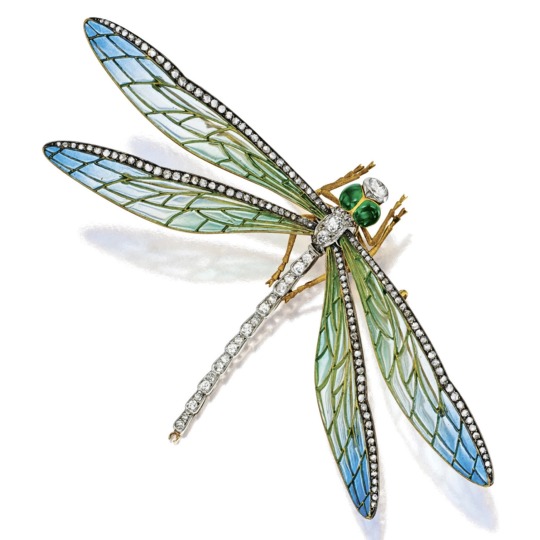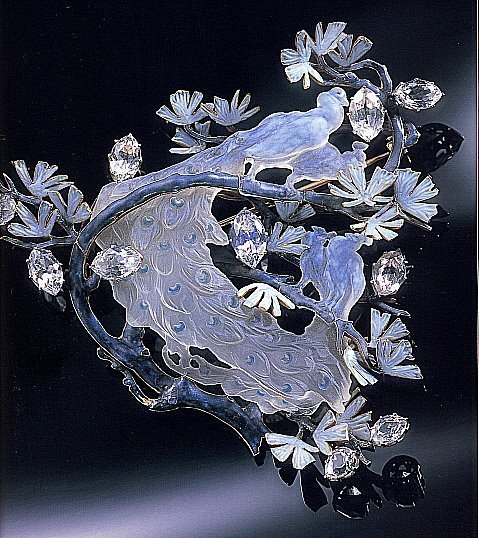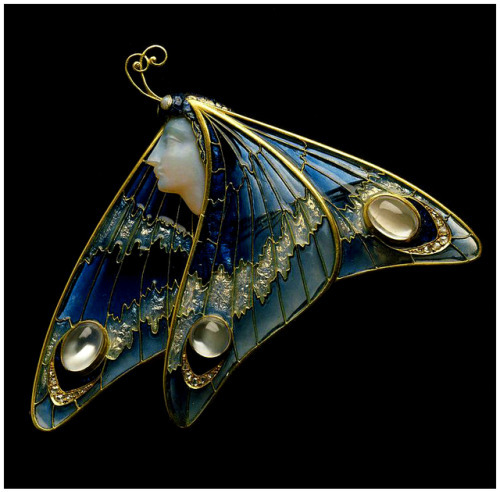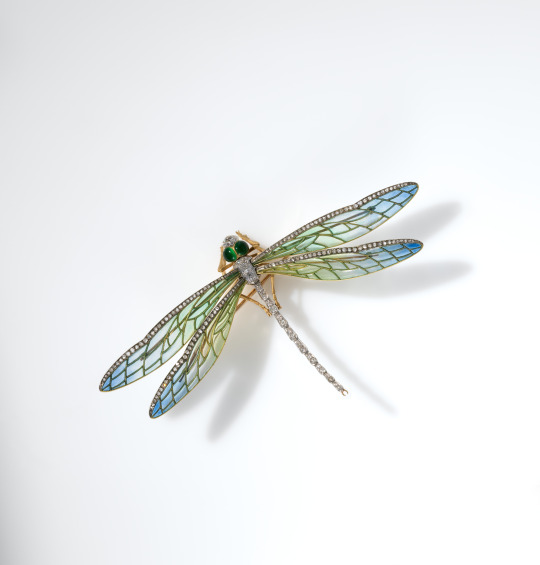#diamond dragonfly brooch
Text

Opal, Diamond and Colored Gemstone 'En Tremblant' Dragonfly Brooch by Gaston Lafitte
Source: 1stdibs.com via Pinterest
#gaston lafitte#dragonfly#dragonfly brooch#insect jewelry#opal#diamonds#opal and diamond brooch#opal and diamond jewelry#high jewelry brooch#high jewelry#luxury jewelry#fine jewelry#fine jewellery pieces#gemville#en tremblant
466 notes
·
View notes
Text

Dragonfly Brooch
.c. 1900
Source : Sotheby’s
115 notes
·
View notes
Text

Art Nouveau Dragonfly Brooch
Designed by Edgar Bense
gold and diamond, ca. 1890
34 notes
·
View notes
Text
A lot of the time when I reblog jewellery on here, it’s art nouveau jewellery, because I really like art nouveau. In general, and in jewellery in particular. And most of that is the aesthetic. I like the natural forms, I like the twisty curly bits, I like the use of materials, I like how a lot of art nouveau jewellery is using metals and stones and other materials to create a specific form, an insect or a plant or a goddess or even sometimes nature scenes. I like …
I feel like a lot of the time with jewellery, it feels like ‘I’m going to use this object to show off the size and value of my pretty rock’. And there’s nothing wrong with that. Some of those rocks are indeed gorgeous. But art nouveau feels more ‘I’m going to use these pretty rocks, and several other things, to create the impact of this object’? I just love the use of materials, glass and enamel and colour, as well as precious stones and metals, to create a form or a scene.
Like, you get a diamond ring, it’s a diamond ring. But you get something like a dragonfly brooch (Louis Acoc):

Or a lilypad hair comb (Rene Lalique):

Or a wisteria branch (Georges Fouquet):

And it’s a whole creation. A little wearable piece of art.
And I don’t want to sound too dismissive. I know the craftmanship and skill and artistry that goes into any kind of jewellery making. That diamond ring took skill I will never have. I just.
I like the emphasis on form more than material that you get with art nouveau. Like normally you hear ‘glass jewellery’, ‘enamel jewellery’, and it’s cheap, it’s frowned upon, but in art nouveau it’s what that glass or enamel was used to make that’s the important part:

(Rene Lalique)

(Eugene Feuillatre)
Anyway. In summary, I really, really, really like art nouveau jewellery?
#art#jewellery#art nouveau#part of this is also that i just love glass as a material#and a lot of the 'cheaper' gems#but i would pay more for that dragonfly than for the largest gem in the world#if money was a thing i actually had anyway#opinions i have them
14K notes
·
View notes
Photo

“I'm the dragonfly rising on the wings of unlocked dreams on the verge of magical things.” …Aimee Stewart #dragonfly #brooch #diamonds #pinksapphires #vintagejewelry #shopcavallofinejewelry (at Cavallo Fine Jewelry) https://www.instagram.com/p/CldxjbZOaXU/?igshid=NGJjMDIxMWI=
0 notes
Text

Brooch
Edgar Bense for Boucheron
c.1890
Conceived as a dazzling dragonfly with delicate plique-à-jour wings, this brooch epitomizes the Art Nouveau style in both fashion and manufacture. With its translucent wings set en tremblant and its sparking rose-cut diamonds, the present jewel catches the light brilliantly. In the enameling technique called plique-à-jour, vitreous enamel is applied to openwork wire cells without a backing, creating the transparent effect of stained glass. The house of Boucheron was founded in 1858 by Frédéric Boucheron (1830–1902). First opened in the Galerie de Valois, under the arcades of the Palais Royal, the shop was perfectly situated in the center of Second Empire Parisian luxury. In 1893 Boucheron moved to the Place Vendôme—the first of the great French houses to occupy that location—where it remains headquartered to this day, with more than 30 branches across the globe.
The MET (Accession Number: Accession Number: 2018.447.1)
#brooch#art history#1890s#art nouveau#jewelry#belle epoque#fashion history#19th century#historical fashion#france#turn of the century#gold#diamond#enamel#the met#those wings just make me go !!!!!!!
594 notes
·
View notes
Text

Diamond Dragonfly Brooch ♕ Queen Maxima
13 notes
·
View notes
Text

When winter gets me down, I put a bit of spring on.
Dragonfly brooch, yellow gold, enamel, amethysts and diamond
4 notes
·
View notes
Text
Victorians had a fascination with natural history. This manifested itself in various ways, not the least of which was in fashionable clothing and décor. A Victorian parlour, for example, might feature a scientific display of pinned butterflies, while insects, such as butterflies, dragonflies, beetles, and grasshoppers, were often depicted in Victorian jewellery. Some insect brooches and hairpins were even set en tremblant (on a spring) so that the jewelled insect would tremble and shake as if it were actually alive. Of these various insects, butterflies were undoubtedly the most well represented in Victorian fashion.
During the 1870s, embroidered butterflies decorated women’s ball gowns and stockings, enamelled butterfly pins adorned ladies’ hats, and diamond butterfly hair ornaments accented fashionable coiffures. Ladies’ magazines of the day also describe black satin shoes with butterfly bows made of jet and brilliantly coloured figured silks designed with butterflies, birds, and flowers. Birds were also well represented in 1870s fashion. Though feathers of every variety had been fashionable throughout the Victorian era, it was not until the 1870s that ladies began to adorn their hats with actual stuffed birds, including doves, cockatoos, bluebirds, robins, and pigeons. The heads, tails, and wings of birds were also used for trimming hats and were often arranged amidst flowers and foliage to appear more natural.
So many birds were used in fashionable dress that, during the nineteenth century, the plumage industry rose up to meet the demand. According to author Stephen Mosley in his book The Environment in World History, London soon became the centre of the international plumage trade, ‘importing and re-exporting bird skins and feathers from the British Empire and elsewhere around the world’. The craze for bird skins and feathers wrought havoc on bird populations and, by the end of the century, bird protection societies had formed in both England and the United States. Unfortunately, the fashion for hats ornamented with stuffed birds and exotic feathers showed no signs of dissipating. It would continue on, reaching its absolute height in the Edwardian Era, before at last fading away in the 1920s.
#victorian era#book : victorian lady guide#feathers#19th century#taxidermy#1870s#fashion#animal#bird#stephen mosley#environmental concern
3 notes
·
View notes
Photo

Brooch Edgar Bense for Boucheron c.1890 Conceived as a dazzling dragonfly with delicate plique-à-jour wings, this brooch epitomizes the Art Nouveau style in both fashion and manufacture. With its translucent wings set en tremblant and its sparking rose-cut diamonds, the present jewel catches the light brilliantly. In the enameling technique called plique-à-jour, vitreous enamel is applied to openwork wire cells without a backing, creating the transparent effect of stained glass. The house of Boucheron was founded in 1858 by Frédéric Boucheron (1830–1902). First opened in the Galerie de Valois, under the arcades of the Palais Royal, the shop was perfectly situated in the center of Second Empire Parisian luxury. In 1893 Boucheron moved to the Place Vendôme—the first of the great French houses to occupy that location—where it remains headquartered to this day, with more than 30 branches across the globe. The MET (Accession Number: Accession Number: 2018.447.1)
4 notes
·
View notes
Note
helaena likes to embroider cute insects and pretty doves on her older sister's dresses, lise always sends to her to make diamond brooches in the shape of spiders, dragonflies or butterflies for hela. <3
lisenya wears all of those dresses with absolute pride, she kisses helaena's cheek in thanks as she gushes over how much she loves them. if someone makes a comment about their embroidery, lisenya will defend it with her life.
lisenya gives her brooches in the shapes of helaena's favorite insects, she gives helaena painting and embroideries of all kinds of spiders, because she knows that Helaena likes them. anything for her younger sister <3
53 notes
·
View notes
Text

Art Nouveau Plique à Jour Enamel, Green Enamel, Blue Sapphire, Pink Sapphire and Diamond Dragonfly Brooch, Circa 1900
Source: sothebys.com via Pinterest
#sothebys#dragonfly brooch#dragonfly#art nouveau#art nouveau jewelry#art nouveau brooch#antique high jewelry#diamonds#plique à jour#enamel#sapphires#pink sapphire#gold#antique enamel jewelry#high jewelry brooch#high jewelry#luxury jewelry#fine jewelry#fine jewellery pieces#gemville
230 notes
·
View notes
Text
Auger, Brooch in the Shape of a Dragonfly, c.1895

Platinum, yellow gold, diamonds, pink rubies, enamel and turquoises.
5 notes
·
View notes
Photo

1900 ART NOUVEAU DRAGONFLY BROOCH
Stunning Art Nouveau dragonfly pin (attributed to Eugene Feuillatre) mounted en tremblant, its wings plique-a-jour enamel and edged in rose-cut diamonds. Its head with green enamel eyes and a diamond. From the original Fred Leighton.
Linda Horn Art Nouveau dragonfly brooch attributed to Eugene Feuillatre, mounted en tremblant, wings plique-a-jour enamel and edged in rose-cut diamonds. Its head with green enamel eyes and a diamond, 1900s.
Eugène Feuillâtre (1870-1916) began his short career as head of René Lalique's enamelling workshop from 1890-97. Though considered a gifted goldsmith and sculptor, his most exceptional talent lay in enamel work and he was considered one of the Art Nouveau's best craftsmen in this field. In 1898, his creations were displayed with great success at the Salon of the Société des Artistes Français. During that year, he also acted as a member of the jury alongside Lalique and Fouquet for an exhibition at the New Gallery in London. By 1899, he began working on his own. He also joined the Belgian association "Libre Estétique" and the Société des Artistes Français with whom he exhibited until 1910. The year 1900 brought him a gold medal at the Paris World Exhibition.
Linda Horn
#1900s#dragonfly#art nouveau#plique-a-jour#linda horn#eugene feuillatre#rose-cut diamonds#lalique#fouquet#new gallery london#Libre Estétique#Paris World Exhibition
15 notes
·
View notes
Text

~ "A beautiful symbol of grace and change, perfectly embodied in this enchanting Art Nouveau dragonfly brooch. A flutter with fern green plique-a-jour wings, a diamond lined abdomen and two cabochon ruby eyes, finished with a sparkling diamond whip lash for a bit of movement. Masterfully hand-fabricated in silver topped 18 Karat gold." ~
2 notes
·
View notes
Text

Dragonfly Brooch, by Georges Auger, c1895. Platinum, yellow gold, diamond roses, pink-coloured ruby squares, enamel and turquoise.
2 notes
·
View notes